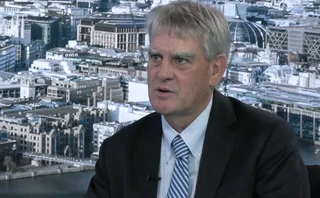
Derivatives house of the year: BNP Paribas
Risk Awards 2019: French bank adds US and flow heft to old strength in Europe and exotics – but patchy performance will require digital savings to arrive earlier

Risk’s annual awards are not about financial performance – that’s why analysts and quarterly results exist. Instead, it’s a chance to put the spotlight on creativity, clarity, ambition, determination.
BNP Paribas demonstrated all these qualities during the judging period – the second half of 2017 and first half of 2018. The bank has a clear, stable strategy for its global markets business; it is investing in its US franchise at a time when other European banks have been retreating; it has fixed risk management problems in its US equity index options business; it has hooked up with non-bank liquidity provider GTS to enhance its cash and derivatives offering; it has built market share on e-trading platforms and with institutional clients; and grasped the nettle in a revamp of its sales and trading teams.
But here’s the rub – although the awards don’t focus primarily on performance, the decisions they highlight should ultimately translate into better returns. And the past 12 months have been mixed for the French bank. Its equity derivatives and structured products businesses have enjoyed a bumper year, but fixed income had already been iffy before a 15% year-on-year decline in the third quarter, announced on October 30.
Speaking a week after those results, Yann Gerardin, chief executive for BNP Paribas’s corporate and investment bank, can still remember some of the brutal headlines.
“I was surprised by some of the coverage. There was one headline about a ‘disaster in bond trading’ – it’s not a disaster if you’re not losing money,” he says.
And he has a ready retort: “The return on equity for the CIB in the third quarter was 16%. I am perfectly happy to compare that to the ROE of my competitors.”
Other articles suggested the bank would need to change course – shrink its markets business as other Europeans have done.
Gerardin says this is based on a fundamental misunderstanding of both the French bank’s identity and the implications of post-crisis prudential reforms. The increased capital requirements of the latter mean banks will have less lending capacity, slowly driving European companies to the capital markets and away from relationship lenders. This is a long-term threat to BNP Paribas, says Gerardin.
“Post-crisis, the CIB strategy has to be fully consistent and aligned with the main characteristics of the bank, and we are the only bank with a network of thousands of midcap customers in France, Belgium, Italy, Germany, Turkey, Poland. No-one else has this kind of presence, so our strategy has to reflect what we are – and this is what we are. If we don’t adapt, we will lose this franchise,” he says.
International connections
Put simply, the bank cannot lend to all of these corporate customers, so will instead need to connect them to international capital markets.
“We need to know who the institutional investors are – around the world – that are going to buy the first high-yield issuance of an Italian midcap in 2025, or a German Mittelstand company in 2030. Without a strong global markets business, there is no way we will be able to help our European clients the way we did in the past,” he says.
This doesn’t sound like a bank about to perform a strategic u-turn, and Olivier Osty – head of global markets for BNP Paribas in London – delivers a similar message.
“The strategy doesn’t need to change, it needs to accelerate,” he says.

Osty chalks this year’s wan performance up to business mix: for a European bank with a strong focus on debt capital markets and derivatives, a moribund euro rates market is always going to be a drag on revenues. Growth on the other side of the Atlantic has provided some insulation, though – Osty estimates the markets business now generates nearly 30% of its revenues in the US, up three percentage points over the past couple of years.
“Over the past year, we’ve invested a lot on growing in the US – and thank God we did, because it compensates to some extent for the fact that investors have left Europe in the past few quarters,” he says. Among other hires, the bank named John Gallo – a veteran of Deutsche Bank, Citi and Lehman Brothers – to the new position of institutional sales head for the Americas.
But this year’s performance will have consequences. The first quarter of 2017 was the last time global markets posted a year-on-year increase in revenues. Since then, in sequence, the year-on-year declines have been 2%, 18%, 16%, 15%, 5% and 8%.
Speaking to analysts when the third-quarter results were announced, Lars Machenil, the bank’s chief financial officer, said sliding revenues would have to be offset by reduced costs.
Osty describes one way in which this will happen – an ambitious revamp of the bank’s sales and trading personnel, which splits the teams into two groups, each with different remits.
On the sales side, staff will reorganise into a macro team and a market access sales team (Mast), reflecting a change in the way some buy-side firms now operate: portfolio managers direct the investment strategy, while trading teams come up with an execution strategy that delivers the correct exposure. At BNP Paribas, the macro sales team will support the portfolio managers, delivering trade ideas and tailored support; the Mast team will work with buy-side traders to ensure they have access to the bank’s liquidity via a variety of channels, including platforms and execution algorithms.
The same kind of split has been discussed by other banks, but BNP Paribas has started to act, Osty says – rates sales is currently being reorganised, and the other asset classes will follow. And the process has been sped up.
“We are aiming to complete in 2019. The original plan was 18 months, but we’re trying to accelerate that,” says Osty.
It will generate savings in different ways, and at different times. Osty says there will be an immediate impact of around 10–15% in headcount, because some of the work of the macro team will be done by Amazon-like tools that match trade ideas and axes to clients’ interests. Some of these tools are already being used in the credit and rates businesses. The Mast teams will be led by senior salespeople, but are also expected to contain a higher proportion of tech-savvy staff, who will on average be more junior.
“Further down the road, we could envisage that our Mast teams may move to less-expensive financial centres. London-based teams could move to Lisbon, Madrid or Milan – where technology talent can be sourced, generating further savings,” Osty adds.
A similar kind of shake-up will also happen in trading. Here, Osty says the amount of risk a trader or desk takes will provide the logic – desks that aren’t taking enough risk will either be merged, or replaced with an algorithm. These proliferating electronic books may not take much risk either, but the cost of running them will be lower.
“There are a lot of initiatives to multiply the different e-books across the firm, in all three regions, to save costs more than generating revenues. This is one of the main challenges for our new head of flow trading, Alexandre Benech,” he says.
Similar logic can be found in BNP Paribas’s year-old tie-up with GTS, the New York-based proprietary trading firm, in which the French bank is able to use US Treasury prices from GTS when clients want to trade the bonds directly, or when BNP Paribas is hedging swaps and other US dollar rates products. In theory, it’s like having a separate pool of better-priced liquidity the French bank can tap on behalf of its clients.
“If we enhance liquidity in the hedging market, then we can improve swaps pricing as well,” says Adil El Batji, head of e-trading, e-commerce and digital for the Americas with BNP Paribas in New York.
Prior to inking the deal, BNP Paribas had been ranked twentieth in e-trading of US Treasuries by volume, with a market share of 1.5%. Eleven months on, it has 4% of the market and is now the tenth-biggest firm.
This has been done profitably for both sides, according to GTS chief executive and co-founder, Ari Rubenstein, who says the partnership “is working as planned commercially”, and on November 15, the two announced plans to expand the tie-up to US equities.
For BNP Paribas, the deal is a way of boosting its visibility in instruments that are the cornerstone of US financial markets – but where competition is fierce and non-banks have the technology and trading strategies required to capture the small margins on offer. GTS, meanwhile, gets exclusive access to flows it may otherwise not see – gold dust for a PTF.
These synergies may seem obvious, but BNP Paribas is one of only a handful of banks to have hammered out a deal – and others have tended to be relatively narrow transactions.
Gerardin is happy with the result: “Our market share in US Treasuries tripled in less than a year. Now we are credible for the top US asset managers – and for swaps trading as well as securities. It makes a difference in the US to be known and recognised.”
The US rates business is also enjoying a strong year in more complex – and lucrative – trades as well.
More complex – and lucrative – rates business, too
A similar story emerges in equities – of increased efficiency in high-volume, low-margin business, coupled with strength in business that requires good ideas and smart traders.
At the low-margin end of US equities, for instance, is a remarkable turnaround story in index options – a business that had gone off the rails in 2017.
“Even though S&P index options are very competitive and you’re not going to extract a lot of value, we see it as a franchise product – everyone expects us to quote. We look at direct revenue but also at positive spillover for the rest of our business,” says Nicolas Marque, global head of equity derivatives with the bank.
In an attempt to make money in this tough market, the business had executed some large positions, but did not hedge in a one-for-one fashion – instead opting for cheaper hedges with slightly different strikes or expiries – keeping more of the spread, at the cost of some residual risk.
When those hedges started underperforming, the bank responded with a trio of changes: setting tighter risk limits, systematically rehedging itself to remove the basis risk, and also becoming more cautious with some client flows. The result: the business is back in profit in 2018, following a revenue swing in the high double-digit millions.
It’s just one story in what has been a hugely successful year for the bank’s equities business, which posted year-on-year gains in every quarter.
Diversification has allowed us to better protect our P&L and protect the book
Emmanuel Dray, BNP Paribas
Other successes can be found at the more complex, ideas-focused end of the business – the bank’s traditional strength – including a record-breaking year in dispersion, and rapid growth in its quantitative investment strategies business.
“Instead of being in responsive mode, picking up the phone and quoting big options on the S&P, we want sales to be proactive and promote products that require a bit more explanation: QIS, exotics and – to a certain extent – some stories in delta one,” says Marque.
One result has been a sea-change in the equity derivatives client base.
“In 2015, our number one client was a hedge fund, and six of the top 10 were also hedge funds. This year, our top client is a real-money asset manager, and only two of the top 10 are hedge funds – the rest are insurance companies, traditional asset managers and pension funds. That diversification has allowed us to better protect our P&L and protect the book,” says Emmanuel Dray, the bank’s global head of institutional sales for equity derivatives.
At this point, the outline of the global markets business starts looking a bit like a vision Gerardin had in 2009, when he was running global equities and commodities for the bank. In essence, he believed banks and their clients would no longer be able to tolerate weak performance, which would produce a focus on two increasingly distinct types of business – commoditised products at one end of the spectrum, and more complex ones at the other. Efficiency and technology would be the keys to competing in the former; creativity and risk-recycling would be the key to the latter.
Some people refer to this as a barbell strategy. Gerardin describes it as an hourglass, with the old approach resembling a rugby ball – lots of underperforming business padding out the middle, where it was difficult to stand out by virtue of either efficiency or creativity.
“What I thought 10 years ago was that our clients would allocate resources in two dimensions – the high-value-added funds on one side, and the low-cost exchange-traded funds on the other – and that banks would be forced to reorganise the workforce in response. We would need an electronic platform, and a smaller number of people, to address the needs of the lower-cost funds, but would still require high-touch sales to address the needs of hedge funds, private equity funds and others. For asset managers and banks, the middle would disappear and this is what’s happening, slowly but surely,” he says.
If a bank can only offer the top or the bottom of the hourglass, however, it will not succeed, he cautions – it needs to offer both simultaneously.
Closer to the hourglass
So, how close is BNP Paribas to the hourglass? “Closer than ever,” he says. “The hourglass is almost perfect in foreign exchange trading; we are implementing it in rates sales, and implementing carefully everywhere else. It’s already been done in equities for quite some time.”
As part of this, the bank has been bolstering its flow and electronic trading credentials, to balance its existing strengths in structured and exotic products. In forex, it was ranked third on trading platform 360T and fourth on Bloomberg, up from fifth and ninth a year ago, respectively; in European government bonds, it ranked second on Bloomberg, up from eleventh; and on US Treasuries it ranked eleventh on both Bloomberg and Tradeweb, up from nineteenth and thirteenth a year ago.
This is the kind of thing Gerardin and Osty are focusing on – capturing and monetising market share, diversifying the client base, and using technology and partnerships to change the way the business works – all of it driven by the long-term conviction that the bank’s corporate clients will ultimately need support from an effective, and integrated, markets business.
The long-term view also comes to the fore elsewhere. Dealers have vast troves of information on client demand, flows and positioning, which could in theory be valuable to asset managers. Some are now in the middle of deep-dive analysis – working out whether the data can be aggregated in such a way that it retains value to some clients, without upsetting others, whose data is being sold.
Not BNP Paribas: “We are not going to commercialise the data of our clients,” says Gerardin.
Was this a position taken after a feasibility study, or cost/benefit analysis?
“No. It’s more a philosophical position. We are a long-term bank and we want to be a long-term partner for our clients. That means we have to be financially strong, we have to show impeccable conduct, and we see this as a conduct issue: we are not going to sell their data,” he says.
Only users who have a paid subscription or are part of a corporate subscription are able to print or copy content.
To access these options, along with all other subscription benefits, please contact info@risk.net or view our subscription options here: http://subscriptions.risk.net/subscribe
You are currently unable to print this content. Please contact info@risk.net to find out more.
You are currently unable to copy this content. Please contact info@risk.net to find out more.
Copyright Infopro Digital Limited. All rights reserved.
As outlined in our terms and conditions, https://www.infopro-digital.com/terms-and-conditions/subscriptions/ (point 2.4), printing is limited to a single copy.
If you would like to purchase additional rights please email info@risk.net
Copyright Infopro Digital Limited. All rights reserved.
You may share this content using our article tools. As outlined in our terms and conditions, https://www.infopro-digital.com/terms-and-conditions/subscriptions/ (clause 2.4), an Authorised User may only make one copy of the materials for their own personal use. You must also comply with the restrictions in clause 2.5.
If you would like to purchase additional rights please email info@risk.net
More on Awards
Collateral management and optimisation product of the year: CloudMargin
Delivering the modern blueprint for enterprise collateral resilience
Flow market-maker of the year: Citadel Securities
Risk Awards 2026: No financing; no long-dated swaps? “No distractions,” says Esposito
Pricing and analytics: fixed income – Quantifi
Quantifi delivers high-performance, transparent and adaptable pricing and risk analytics for fixed income and credit markets
Derivatives house of the year: Citi
Risk Awards 2026: Rev up, RWAs down, as US bank gets back on track (with added XiNG and XiP)
Technology vendor of the year: SS&C Algorithmics
Risk Awards 2026: From cloud, to chips, to maths tricks – vendor getting more out of existing tech
SS&C Algorithmics: winner’s interview with Curt Burmeister
SS&C Algorithmics wins three categories in this year’s Markets Technology Awards in addition to Technology vendor of the year at the Risk Awards
Best vendor for system support and implementation: Murex
Murex wins Best vendor for system support and implementation at the Markets Technology Awards 2026
Pricing and analytics: cross-asset and structured – Murex
Murex wins Pricing and analytics: cross-asset and structured at the Markets Technology Awards 2026 thanks to its MX.3 platform







